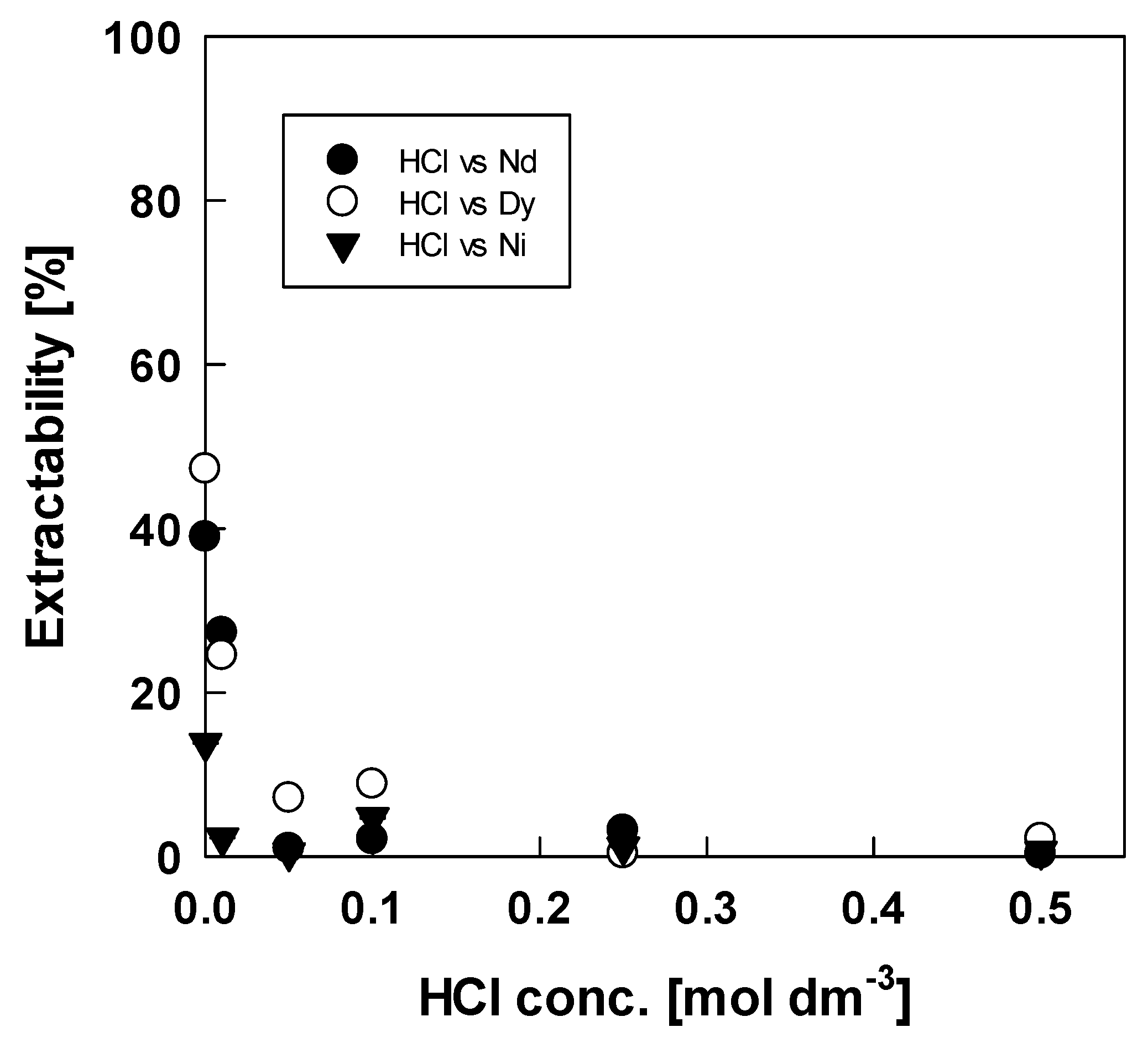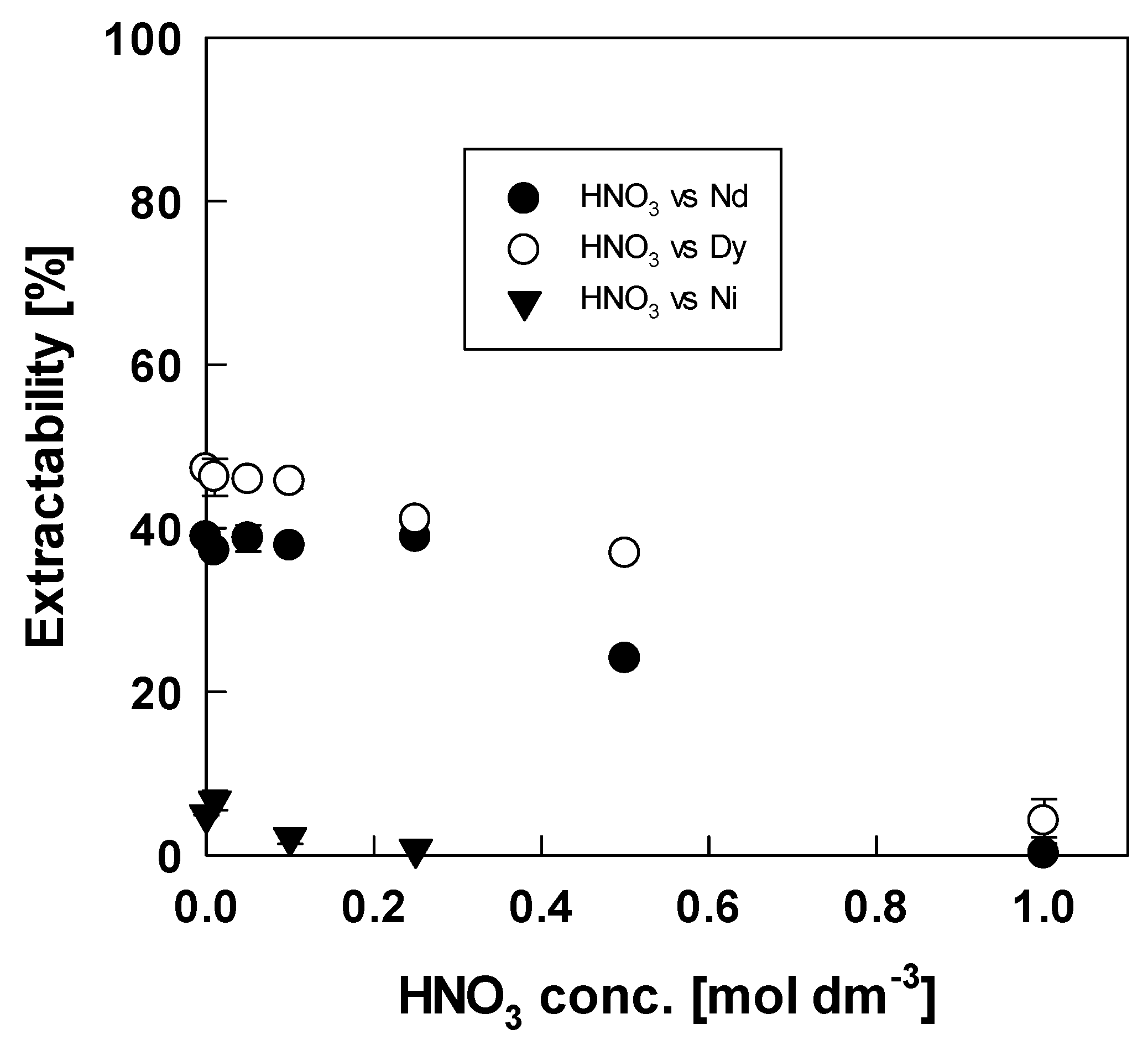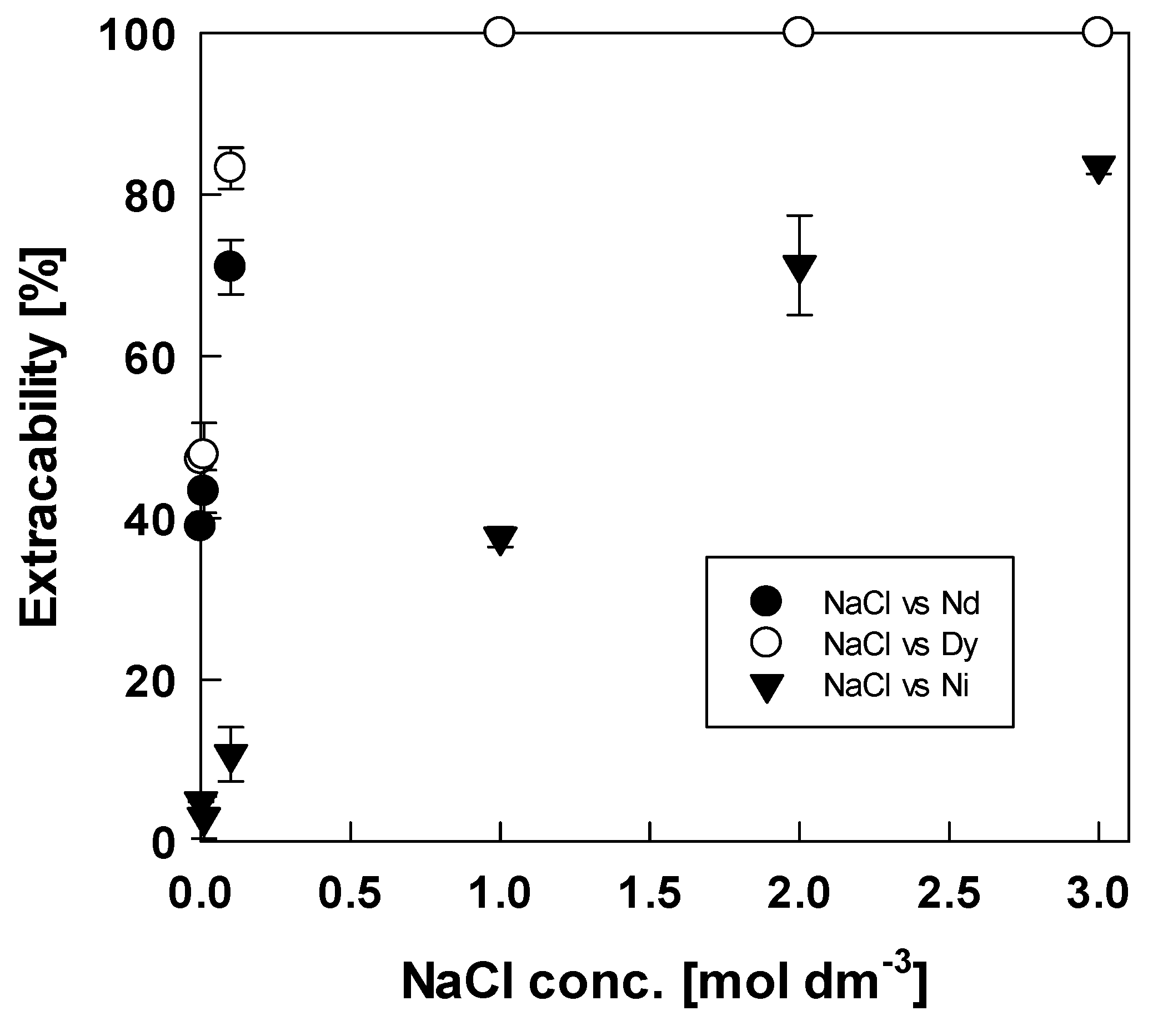Extraction of Rare Earth Metal Ions with an Undiluted Hydrophobic Pseudoprotic Ionic Liquid
Abstract
:1. Introduction
2. Materials and Methods
3. Results
3.1. Extraction of Metal Ions from Aqueous Acid Solutions
3.2. Effect of Salts on Metal Extractability
4. Conclusions
Author Contributions
Funding
Conflicts of Interest
References
- Gergoric, M.; Ekberg, C.; Foreman, M.R.; Steenari, B.; Retegan, T. Characterization and leaching of neodymium magnet waste and solvent extraction of the rare-earth elements using TODGA. J. Sustainable Metall. 2017, 3, 638–645. [Google Scholar] [CrossRef] [Green Version]
- Ferron, C.J.; Henry, R. A review of the recycling of rare earth metals. Can. Metall. Q. 2015, 54, 388–394. [Google Scholar] [CrossRef]
- Ismail, N.A.; Aziz, M.A.A.; Yunus, M.Y.M.; Hisyam, A. Selection of extractant in rare earth solvent extraction system: A review. Int. J. Recent. Technol. Eng. 2019, 8, 728–742. [Google Scholar]
- Gergoric, M.; Ravaux, C.; Steenari, B.; Espegren, F.; Retegan, T. Leaching and recovery of rare-earth elements from neodymium magnet waste using organic acid. Metals 2018, 8, 721. [Google Scholar] [CrossRef] [Green Version]
- Gergoric, M.; Barrieri, A.; Retegan, T. Recovery of rare-earth elements from neodymium magnet waste using glycolic, maleic, and ascorbic acids followed by solvent extraction. J. Sustainable Metall. 2019, 5, 85–96. [Google Scholar] [CrossRef] [Green Version]
- Mi’am, A.C.; Wang, Y.; Chen, S.; Chang, G.; You, S. Simultaneous recovery of rare earth elements from waste permanent magnets (WPMs) leach liquor by solvent extraction and hollow fiber supported liquid membrane. Chem. Eng. Process. 2020, 148, 107831. [Google Scholar]
- Padha, E.; Nayak, A.K.; Sarangi, K. Recovery of neodymium and dysprosium from NdFeB magnet swarf. Hydrometallurgy 2017, 174, 210–215. [Google Scholar] [CrossRef]
- Habaki, H.; Nakamura, K.; Egashira, R. Extraction equilibria of valuable metals from NdFeB permanent magnet using carboxylic acid as extractant. J. Chem. Eng. Jpn. 2017, 50, 610–617. [Google Scholar] [CrossRef]
- Deshmane, V.G.; Islam, S.Z.; Bhave, R.R. Selective recovery of rare earth elements from a wide range of E-waste and process scalability of membrane solvent extraction. Environ. Sci. Technol. 2020, 54, 550–558. [Google Scholar] [CrossRef]
- Kumari, A.; Sahu, K.K.; Sahu, S.K. Solvent extraction and separation of Nd, Pr and Gy from leach liquor of waste NdFeB magnet using the nitrate form of Mextral33At in the presence of aquo-complexing agent EDTA. Metals 2019, 9, 269. [Google Scholar] [CrossRef] [Green Version]
- Guo, L.; Chen, J.; Shen, L.; Zhang, J.; Zhang, D.; Deng, Y. Highly selective extraction of rare earth (III) using bifunctional ionic liquid extractant. ACS Sustainable Chem. Eng. 2014, 2, 1968. [Google Scholar] [CrossRef]
- Katsuta, S.; Yoshimoto, Y.; Okai, M.; Takeda, Y.; Bessho, K. Selective extraction of palladium and platinum from hydrochloric acid solutions by trioctylammonium-based mixed ionic liquids. Ind. Eng. Chem. Res. 2011, 50, 12735–12740. [Google Scholar] [CrossRef]
- Katsuta, S.; Okai, M.; Yoshimoto, Y.; Kudo, Y. Extraction of gallium (III) from hydrochloric acid solutions by trioctylammonium-based mixed ionic liquids. Anal. Sci. 2012, 28, 1009–1012. [Google Scholar] [CrossRef] [PubMed] [Green Version]
- Janssen, C.H.C.; Macías-Ruvalcava, N.A.; Aguilar-Martínez, M.; Kobrak, M.N. Copper extraction using protic ionic liquids: Evidence of the Hofmeister effect. Sep. Purif. Technol. 2016, 168, 275–283. [Google Scholar] [CrossRef]
- Pavón, S.; Fortuny, A.; Coll, M.T.; Sastre, A.M. Neodymium recovery from NdFeB magnet wastes using Primene81R-Cyanex 572 IL by solvent extraction. J. Environ. Manage. 2018, 222, 259–367. [Google Scholar] [CrossRef]
- Patsos, N.; Lewis, K.; Picchioni, F.; Kobrak, M.N. Extraction of acids and bases from aqueous phase to a pseudoprotic ionic liquid. Molecules 2019, 24, 894. [Google Scholar] [CrossRef] [Green Version]
- Hoogerstraete, T.V.; Wellens, S.; Verachtert, K.; Binnemans, K. Removal of transition metals from rare earths by solvent extraction with an undiluted phosphonium ionic liquid: Separations relevant to rare-earth magnet recycling. Green Chem. 2013, 15, 919–927. [Google Scholar] [CrossRef] [Green Version]
- Lee, C.; Chen, Y.; Liao., C.; Popuri, S.R.; Tsai, S.; Hung, C. Selective leaching process for neodymium recovery from scrap Nd-Fe-B magnet. Metall. Mater. Trans. 2013, 44, 5825–5833. [Google Scholar] [CrossRef]
- Önal, M.A.R.; Atkan, E.; Borra, C.R.; Blanpain, B.; van Gerven, T.; Guo, M. Recycling of NdFeB magnets using nitration, calcination and water leaching for REE recovery. Hydrometallurgy 2017, 167, 115–123. [Google Scholar] [CrossRef]
- Sato, T. Extraction of some mineral acids by tri-n-octylamine. J. Appl. Chem. 1965, 15, 10–16. [Google Scholar] [CrossRef]
- Liu, L.; Tian, G.; Rao, L. Effect of solvation? Complexation of neodymium (III) with nitrate in an ionic liquid (BUMIMTF2N) in comparison with nitrate. Solvent Extr. Ion Exch. 2013, 31, 384–400. [Google Scholar] [CrossRef]
- Wang, W.; Yang, H.; Cui, H.; Zhang, D.; Liu, Y.; Chen, J. Application of bifunctional ionic liquid extractants [A336][CA-12] and [A336][CA-100] to the lanthanum extraction and separation from rare earths in the chloride media. Ind. Eng. Chem. Res. 2011, 50, 7534–7541. [Google Scholar] [CrossRef]
- Komasawa, I.; Hisada, K.; Miyamura, M. Extraction and separation of rare-earth elements by tri-n-octylmethylammonium nitrate. J. Chem. Eng. Jpn. 1990, 23, 308–315. [Google Scholar] [CrossRef] [Green Version]




| D1 | Nd | Dy | |
|---|---|---|---|
| D2 | |||
| Ni | 25.1 | 30.1 | |
| Nd | - | 1.12 | |
| D1 | Nd | Dy | |
|---|---|---|---|
| D2 | |||
| Ni | 50.6 | 57.1 | |
| Nd | - | 1.13 | |
© 2020 by the authors. Licensee MDPI, Basel, Switzerland. This article is an open access article distributed under the terms and conditions of the Creative Commons Attribution (CC BY) license (http://creativecommons.org/licenses/by/4.0/).
Share and Cite
Matsumoto, M.; Yamaguchi, T.; Tahara, Y. Extraction of Rare Earth Metal Ions with an Undiluted Hydrophobic Pseudoprotic Ionic Liquid. Metals 2020, 10, 502. https://doi.org/10.3390/met10040502
Matsumoto M, Yamaguchi T, Tahara Y. Extraction of Rare Earth Metal Ions with an Undiluted Hydrophobic Pseudoprotic Ionic Liquid. Metals. 2020; 10(4):502. https://doi.org/10.3390/met10040502
Chicago/Turabian StyleMatsumoto, Michiaki, Takuya Yamaguchi, and Yoshiro Tahara. 2020. "Extraction of Rare Earth Metal Ions with an Undiluted Hydrophobic Pseudoprotic Ionic Liquid" Metals 10, no. 4: 502. https://doi.org/10.3390/met10040502






